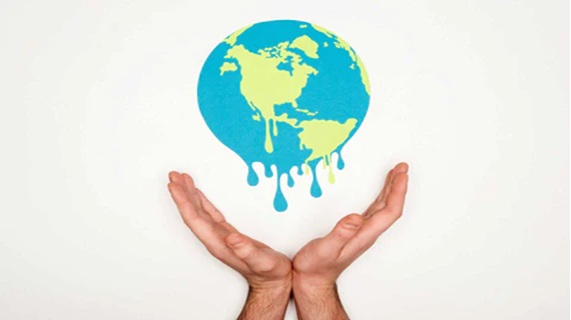| UPSC Mains: General Studies-III (Environment) |
Climate change is affecting all life forms and human societies directly and indirectly. It results in extreme weather events, rising sea levels, melting glaciers, and biodiversity loss. These impacts are particularly severe for vulnerable communities, marginal farmers, Small Island Developing States (SIDS), and environmental resources.

Impact on Vulnerable Sections
Impact on Women
- Displacement: 80% of people displaced due to climate change and extreme weather events are women. (United Nations)
- Adaptation Finance: Only 2% of international adaptation finance is spent on women-focused projects. (Adaptation Gap Report)
- Disaster Impact: Women and children are 14 times more likely to die than men during disasters. (UNDP)
- Livelihoods: Women constitute 43% of the agricultural workforce in developing countries, making them highly vulnerable to climate change. (FAO)
Conclusion: Climate change disproportionately affects women’s social and economic security, health, and education.
Impact on Indigenous Communities
- Traditional Governance: Displacement and forced relocation weaken their traditional governance systems.
- Discrimination and Abuse: Indigenous communities often face social discrimination and abuse under new conditions.
- Cultural and Spiritual Impacts: Species extinction, habitat loss, and depletion of natural resources affect traditional medicine and spiritual practices.
- Livelihood Threats: 40% of indigenous land lies in highly biodiverse, climate-sensitive areas.
- Health Impacts: Increased risk of heat-related illnesses, vector-borne diseases, and malnutrition, compounded by limited healthcare access.
Impact on Marginal Farmers
- Extreme Weather: Over one-third of marginal farmers faced at least two extreme weather events in the past five years.
- Decline in Agricultural Income: 15–18% decline overall; 20–25% in non-irrigated areas. (Economic Survey 2017-18)
- Livelihood Changes: Over 86% of farmers changed occupations temporarily due to migration.
- Barriers to Climate-Smart Agriculture: High initial costs, small land holdings, and limited physical resources.
Potential Solutions: Promote climate-resilient agriculture, disaster-resilient infrastructure, and shared resources through cooperatives.
Impact on Small Island Developing States (SIDS)
Key Impacts:
- Forced Displacement: Panama was the first country to relocate an island community due to climate threats.
- Economic Losses: $153 billion lost to extreme weather between 1970–2020.
- Funding Shortfall: Only $1.5 billion received out of $100 billion climate finance in 2019.
- Climate Injustice: SIDS contribute only 1% of global greenhouse gas emissions but are disproportionately affected.
International Initiatives:
- AOSIS: Intergovernmental alliance representing SIDS.
- Barbados Programme of Action (1994): Global conference for sustainable development of SIDS.
- CDRI – IRIS Program: $8 million funding for resilient island infrastructure.
- IRAF (2022): $50 million endowment by UNDP and UNDRR.
Way Forward:
- Nature-based solutions (e.g., blue carbon projects, degraded ecosystem restoration)
- Renewable energy initiatives (SIDS Lighthouse initiative: 10 GW target by 2030)
- Financial support via SDG relief packages and climate-resilient investments
Socio-Economic Impacts
Health Impacts
- Key Risks: Injuries/deaths from extreme weather, heatstroke, vector-borne diseases, mental health effects.
- One Health Approach: Recognizes the interconnection between humans, animals, plants, and the environment.
- Heat Risks: 50 extra dangerous heat days per year (2023).
- Non-Communicable Diseases: 85% of deaths from NCDs linked to climate change and air pollution.
Education Impacts
- School Closures: 75% of extreme weather events between 2005–2024 led to school closures.
- Learning Outcomes: 1°C increase in temperature negatively affects exam performance.
- Gender-Based Impact: 4 million girls’ education affected.
- Cognitive Skills: Extreme rainfall impacts children’s language and mathematics skills.
- Early Warning Systems: Indonesia’s InaRISK mobile app.
- Way Forward: Strengthen school infrastructure, “Back to School” campaigns, and climate education.
Impact on Geological Resources
- India’s Average Temperature (1901–2018): +0.7°C
- Extreme Rainfall Frequency (1950–2015): 75% increase
- Northern Indian Ocean Sea Level (1993–2017): 3.3 mm/year rise
Impact on Oceans and Water Resources
- Ocean Temperature Increase: Average +1.45°C; hotspots include the Mediterranean, tropical Atlantic, and Southern Ocean.
- Acidification: ~25% of human-emitted CO₂ absorbed by oceans.
- Blue Carbon Ecosystems: 20–35% loss in mangroves, seagrass, and tidal marshes.
- Rivers: 2023 was the driest year for global rivers.
Sea Level Rise
- Global: 4.77 mm/year (2014–2023)
- India: Maximum 4.44 cm in Mumbai; by 2040, 10% land in many coastal cities could be submerged.
- Impacts: Coastal ecosystems, fisheries, freshwater salinization, displacement.
- Mitigation: Flood barriers, ecological protection, modeling, floating cities.
Impact on Cryosphere (Glaciers and Ice Caps)
- Definition: Continental ice, glaciers, ice caps, permafrost.
- Key Impacts:
- Greenland loses 30 million tons of ice per hour.
- 50% of Himalayan glaciers could disappear with a 2°C rise.
- Vegetative cover increasing in Antarctica.
- Consequences: Accelerated climate change, sea-level rise, water availability issues, weakened ocean circulation.
- International Initiatives: Glacier Conservation Year 2025, UNESCO Hydrological Program, IUCN Himalayan Network, WWF Living Himalayas.
- India’s Initiatives:
- National Mission on Sustaining Himalayan Ecosystem
- INCOIS Glacier Monitoring
- NCPOR Research Stations (Antarctica, Arctic, Himalayas)
Way Forward
- Improve data collection and technical capacity
- Strengthen financial mechanisms and adaptation measures
- Promote nature-based solutions and renewable energy
- Make health, education, and social protection systems climate-resilient
- Coordinate local efforts with international frameworks


